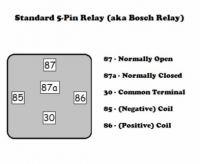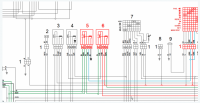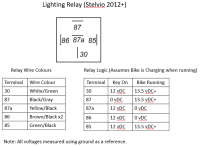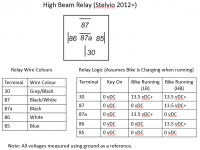Assuming the on was with the bike actually running....just to be sure.
If it was with the bike running then you are correct, it is not transferring power from the 87A terminal (middle on you diagram) to the 87 terminal (far right). It looks like it is getting power from the 30 amp fuse (terminal 30.. far left terminal on your drawing) and that the trigger is getting power (86... bottom terminal on your drawing). Can't believe both relays show the same thing. If the trigger terminals (86 and 85) have power, the relay has to fire.
Your relay is not working. Easy way to test that it is the relay it put a wire jumper between terminal 30 and 87 (far left and far right terminal in your drawings) and then start the bike (can insert a wire to the back of the relay plug). If it is the relay the charging should start and the lights come on when you start it.
The trigger is getting power but it is not flipping the contact. May just need a good tap on the side. They do get stuck. Try taking it apart and see if you can see something obvious. May just need a cleaning. Either way, get a new one as it is trash.

If it was with the bike running then you are correct, it is not transferring power from the 87A terminal (middle on you diagram) to the 87 terminal (far right). It looks like it is getting power from the 30 amp fuse (terminal 30.. far left terminal on your drawing) and that the trigger is getting power (86... bottom terminal on your drawing). Can't believe both relays show the same thing. If the trigger terminals (86 and 85) have power, the relay has to fire.
Your relay is not working. Easy way to test that it is the relay it put a wire jumper between terminal 30 and 87 (far left and far right terminal in your drawings) and then start the bike (can insert a wire to the back of the relay plug). If it is the relay the charging should start and the lights come on when you start it.
The trigger is getting power but it is not flipping the contact. May just need a good tap on the side. They do get stuck. Try taking it apart and see if you can see something obvious. May just need a cleaning. Either way, get a new one as it is trash.









